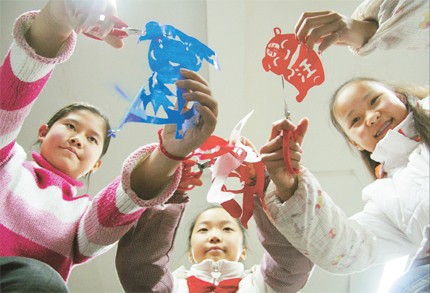 |
|
Students demonstrate their papercutting skills. Paper-cutting is a unique Chinese art form, which has existed for centuries. [Shanghai Daily] |
Snippets of China's culture are revealed through paper-cuts to American students learning Chinese in Chicago.
No lines, no patterns, no drawings ... simply a piece of bright red paper, a pair of scissors and deft hands were all Li Wang, a well-known Chinese paper-cutting artist, needed to make magic unfold in front of American students at LaSalle Language Academy in Chicago.
Moments later, after Li had skillfully zigzagged through the square of folded paper, an exquisite paper-cut emerged: a dragon's head. The students were absolutely in awe of Li's stunning presentation recently, which resembled a magician's pulling a rabbit out of a hat. One clever student who had correctly guessed what Li was making received the paper-cut as a gift.
Emma Wang, an 11-year-old student, was stunned by Li's presentation. "It is such a fun way to learn Chinese and its culture," she exclaims.
"I can't believe he does it so fast, and it is really cool!" Sabine Zinserling says.
Lena Doughty was impressed by how quickly Li had cut out the dragon's head. "It is good to see how he does it, and it does help us understand Chinese culture better," she remarks.
After watching the demonstration of the paper-cutting master, the students were given the chance of wielding scissors themselves by cutting out a Chinese vase.
Z. J. Tong, founder and president of the Chicago Chinese Culture Institute, sponsored this cultural activity along with the Chicago Confucius Institute.
Standing by Li's side, Tong told the students about the history and meaning behind this unique and endangered Chinese art form, which has existed for centuries.
"The oldest surviving paper-cut came from the 6th century. From the 7th to the 13th centuries, it became very popular and was spread to the rest of the world in the 14th century," Tong says.
Tong was also asked about the meaning and function of paper-cuts. "They are mostly decorations for walls, windows, doors and lanterns during Chinese festivals. They represent good luck, prosperity, health or harvest," he answers.
Li was taught the art of paper-cutting from his grandmother at the age of six. He has become so adept at it that he can cut out many traditional Chinese designs without following any patterns. Li, who is currently a member of the Chinese International Art Association, has won a number of prizes in China.
"I am very excited to be here to show American students our traditional Chinese paper-cutting," Li says. "Our traditional Chinese culture not only needs to be passed down from generation to generation, but also needs to be communicated to other cultures."
When asked why he had started such a cultural exchange program, Tong says: "Many Americans are learning Chinese now, especially in the Chicago public schools, where about 12,000 students are learning Chinese. This kind of cultural exchange will help American students better understand our country and our culture, and I am very glad to be able to help promote cultural exchange between China and the United States."
Jialing Chen, a Chinese-language teacher at LaSalle Language Academy, says: "I currently have about 80 students learning Chinese here. They were very excited when I told them about the paper-cutting activity. It indeed promotes their understanding and stimulates their interest in learning Chinese language, culture and history."
Elisabeth Heurtefeu is the principal of LaSalle Language Academy, which teaches five languages in its World Language Program. Being an open-minded cosmopolitan person herself, Heurtefeu is passionate about bringing different cultures together in her school.
"We were very interested in hosting it because we love to introduce Chinese culture to our students," she explains.
Heurtefeu is planning to visit China with Chen in a couple of weeks to explore the possibility of a cultural exchange program between her school and a Chinese school.
"I am very excited about the upcoming visit to China, and we are looking forward to starting a partnership with a Chinese school in the near future," she says.
Bridget Veritch, coordinator of the World Language Program, is also enthusiastic. "Our Chinese program is becoming very popular at our school, and next year we expect to have about 100 students. It is wonderful to have a Chinese artist come here today. Any hands-on activity can help students learn so much. You can see how interested they are."
During his three-week visit, Chinese artist Li held popular presentations at about 20 public schools in Chicago.
(Shanghai Daily November 12, 2009)